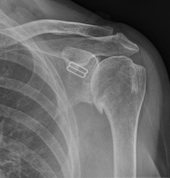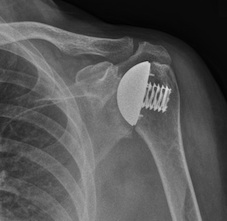What is it?
Normal joints are covered with a soft glistening smooth white tissue called cartilage which acts as a bearing surface to allow the joint to move freely. If the cartilage is damaged the surface becomes rough and no longer glides. This is called arthritis and can cause pain and stiffness within the joint.
The rotator cuff is a group of muscles within the shoulder which are responsible for keeping the joint centred while it moves.
What Causes it?
- Osteoarthritis: Less common in the shoulder than in the hip and knee. It may be genetic (inherited) or may be due to heavy manual work but a specific cause is usually not found.
- Rheumatoid arthritis: This condition affects joints and organs throughout the body. It affects the soft tissues (rotator cuff) as well as the cartilage
- Trauma: If the shoulder joint has been broken (fractured) or dislocated at some point the cartilage may have been damaged and the tendons can be torn

What are the symptoms?
Pain is usually the first complaint. It is often felt deep in the shoulder and may be difficult to locate precisely. The shoulder may feel stiff and weak. There may be a sensation of grinding or catching within the shoulder. On occasion there may be crunching which can be heard.
How is the diagnosis made?
The doctor will listen to the description of the symptoms and will examine the shoulder. Plain X-rays are usually sufficient to make the diagnosis. If there is a concern that there may be more than arthritis in the shoulder (e.g. a rotator cuff tear) further investigations will be performed. MRI and CT scans may also be undertaken.
What is the initial treatment?
There is no cure for arthritis. If the cause is rheumatoid arthritis a rheumatologist will be involved to optimise the medications to control the condition. If one of the other causes is responsible initial treatment consists of painkillers and anti-inflammatories. Exercise modification (avoiding the things that hurt) may help.
If pain is a problem then a Suprascapular Nerve block can be a good option.
If initial treatment doesn’t work, what’s next?
Corticosteroid injection into the shoulder can give pain relief. The amount of benefit is variable as is the duration which may be as little as days or as long as months. This should not be done within 6 months of any planned shoulder replacement as there is an increased risk of infection.
Arthroscopy and debridement in which the arthroscope is introduced into the shoulder and the rough cartilage is smoothed down also has variable results with benefits as available as those seen with injection although usually longer lasting.
Shoulder replacement in which the arthritic shoulder joint is replaced with a new one of metal and plastic can give relief of pain in 90% of patients. The replacements last on average 15 years.
Anaesthetic
General Anaesthetic with an interscalene block (You will be fully asleep and a local anaesthetic injection into the side of the neck will numb the nerves to the shoulder for post-operative pain relief)
Incision
An 8cm incision will be made in the front of the shoulder in the “deltopectoral groove”. This runs from just below the collar bone straight down towards the armpit.
Procedure
The muscles over the front of the shoulder will be pulled to the side and the subscapularis muscle will be divided to allow access to the joint. The head of the humerus (arm bone) will be shaped and the bone prepared to receive the implant. The face of the glenoid (the body side of the joint) will also be prepared to receive a new surface.
The new shoulder joint will be inserted and fixed into place.
The tissues will be sewn back to their original positions.
There are several different types of reverse shoulder replacement I prefer the one made by Arthrex

Eclipse x-ray 
Eclipse
Pain relief
The anaesthetist will discuss a nerve block which will be administered after you are asleep, this means that you will wake up with no pain in the shoulder but the arm will feel numb for up to 12 hours. You will be prescribed painkillers to start taking when you get home and we encourage you to take these regularly for at least the first few days. There will be some discomfort but this settles quite rapidly and ice packs can be used in addition if you wish.
Wound Closure
A single long dissolving stitch under the skin and paper stitches over the top will be used to close the wound. These stitches do not need to be removed
Dressings
A Tegaderm dressing will be placed over the top of the paper stitches.
Surgical Risks
Every operation has a degree of risk. It is important that you are aware of these risks before you agree to proceed with your operation.
If you decide not to proceed with surgery there is a possibility that the symptoms will settle on their own but they may continue and they may get worse. You will not damage the shoulder if you decide not to proceed with surgery.
The most common or significant risks are outlined below. A risk of 0.1% means that 1 in 1000 people will suffer the complication
- Failure of the procedure to relieve symptoms: 5%
- Superficial Infection (requiring antibiotics): 1%
- Deep Infection (requiring further surgery): <1%
- dislocation of the shoulder requiring further surgery: 5%
- Loosening of the implant requiring further surgery: 5%
- requring some form of surgery in the next 5 years: 7%
- PE (Pulmonary Embolus) (Blood clot in the lung): 0.13% – Blood thinning medication is required for several months. Can rarely result in death.
- DVT (Deep Vein Thrombosis) (Blood clot in the leg): 0.14% – Blood thinning medication is required for several months. Can lead to PE
- Nerve Injury: 0.01% – Usually temporary. Can cause weakness around the shoulder with loss of function and rarely can be permanent.
- Heart attack: 0.02%
- To put these numbers in perspective
The chance of:- Getting three balls in the UK national lottery: 0.9%
- Needing emergency treatment in the next year after being injured by a can, bottle, or jar: 0.1%
- Death by an accident at home: 0.01%
- For a 50 year old man in good health the 5 year risk of dying is 0.8%
Rehabilitation after surgery
You will wake up with a sling on your arm and your arm may feel numb for the rest of the day. There will be an IV line (a drip) in your other arm. A vacuum drain may be connected to your operated shoulder.
You will need to remain in hospital until the drain is removed and you are comfortable. Typically patients go home about 48hours after surgery. A physiotherapist will see you and you will be given instructions on what to do next.
Before Discharge
Day 1:
- You may shower with the dressings on but do not immerse the wound in water for 2 weeks. Start gentle exercises to prevent elbow and wrist from becoming stiff.
- X-rays to confirm implant position
Day 2 (approx):
- Start exercises for the shoulder
- No Active Internal Rotation (hand behind back)
- External Rotation to the limit set in the Operation Note
Discharge: When comfortable. This is usually on day two.
Discharge to 3 weeks
- Sling to be worn for comfort, this is usually outside the house but mostly not necessary inside.
- Some people prefer to wear it at night but this is not essential.
- Exercises as instructed.
- Remove the dressings at 10-14 days.
- The paper stitches will peel off easily. No stitches need to be removed.
- You will be seen in clinic at 3 weeks where plans for formal physiotherapy will be made.
Progress is very individual and will depend on a number of preoperative factors including
- The severity of the arthritis
- The condition of the muscles
- The stiffness of the joint
Improvement can be seen for up to 18 months following surgery
Frequently asked questions
Return to work after surgery
This is very much dependent on the type of work that you do, whether you need to drive to get to work and the type of surgery that you have had done.
You, as the patient, have the best idea of the specific demands that are required of you to do your work safely and effectively.
Having an operation with an anaesthetic often takes more out of people than they would expect. Generally it is probably worth taking at least a week off from your regular work after having had any procedure.
You should discuss expected post-operative recovery and work with the surgeon before your operation.
Driving after surgery
To be able to drive safely you should be capable of actively moving your shoulder without assistance and without damaging the surgical repair. You should be able to react normally to avoid causing injury to yourself or others due to a lack of control.
Typically this is a MINIMUM eight weeks after surgery.
It is a UK requirement that, unless specific dispensation has been granted by the DVLA, a driver uses both arms to control the steering wheel.
It is the responsibility of the driver to ensure that they are in control of the vehicle at all times. They should be able to demonstrate this if stopped by the police.
It is not a requirement to notify the DVLA unless the medical conditions likely to affect safe driving persist for longer than three months after the date of the surgery.
Drivers must not drive under the influence of narcotic medications or within a minimum of 24 hours after an anaesthetic.
You are not allowed to drive one-handed and therefore cannot drive whilst you are in the sling.
There is no precise time after surgery when you can return to driving, it varies from person to person. However, the recommended amount of time that your arm should be in a sling following surgery is the MINIMUM time before considering a return to driving.
You can return to driving when you are capable of moving your shoulder without assistance and are capable of driving safely and reacting appropriately in an emergency situation.
Although it is not essential, it may be wise to discuss your return to driving with your car insurance company.
Sports after surgery
You can start simple cardio such as walking or using a static bicycle immediately following surgery as long as you are wearing your sling. Exercises which involve the shoulder cannot start until you have regained reasonable range. This is typically about eight weeks following surgery.
Shoulder Replacement is very effective but the shoulder will not be 100% normal.
Contact sports, repetitive overhead sports (such as tennis) and sports in which you are likely to fall over should be avoided.
Therapist Information
- The Subscapularis muscle will have been detached and re-attached as part of the operation. This is why the range of motion in external rotation may be limited for a time.
- With this limit it is still important to start to move the shoulder as soon as possible as pain allows.
- Many of the muscles will not have been used for some time due to pain and stiffness. Rehabilitation may therefore be slow.
- Please check the operation note for full details of the procedure performed.